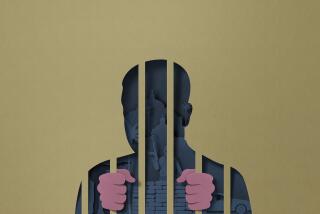Without Follow-Up, Gang Sweep Will Just Be a Big Bust
John Raya attended Wednesday’s press conference and listened quietly as the cops and politicians hailed the street sweep that they said would put a big dent in one of Santa Ana’s roughest gangs. Authorities said they ultimately were going to arrest 130 gang members and thereby return some tranquillity to a beleaguered neighborhood.
Raya was on hand for a couple reasons. As a citizen volunteer when “Operation Roundup” culminated Wednesday, he was on the cleanup crew, helping tidy up after the officials involved in the sweep had been fed.
But Raya’s interest went far beyond seeing that cops got sandwiches and that plates were picked up.
He’s the general manager of a plumbing company in Orange but still lives in Santa Ana. He grew up on Minnie Street in Santa Ana, a street that has seen its share of violence. He has three children, ages 9, 15 and 17, all of whom attend Santa Ana public schools. He’s talked with all of them about the dangers in the streets and in turn heard their stories of “friends of friends” who have been shot.
He has a stake in a safer Santa Ana. Accordingly, he was happy to hear about the squeeze applied to street criminals. But he sat through the press conference wanting to hear much more than simple arrest figures.
“Did what happened (Wednesday) need to happen?” he says, referring to the sweep. “Yes, no doubt in my mind.”
But what he didn’t hear was, “What do we do now?”
“I tell people I’m a pragmatic person,” Raya says. “I’m the manager of a business . . . and I understand these things from the perspective that says the way money works is you reap benefits based on commitment and investment. You can take the junk-bond approach and roll the dice or you can play long term.”
What’s missing in Santa Ana’s approach--or, for that matter, America’s approach to crime--is the long term, Raya says. “What I’ve observed is that politicians have to take things neat, easy and clean and they don’t want the risk of leadership.”
Devising crime-prevention programs is where leadership comes in, Raya says, but politicians “are not sure they work, and if there’s any margin of doubt then they think it’s better not to do it. They say, ‘Let’s continue to do what we know doesn’t work but since everybody else does it, we won’t be blamed for failure.’ ”
Raya has fashioned a 17-point program that attempts to be an across-the-board approach to stemming youth violence. It runs the gamut from enforcing parental responsibility for their children’s offenses to “Youth Corps” programs to anti-drug classes to job training to expanded library services.
Raya has sent his proposals to various public officials, and while some elements are practiced, it is the scope and commitment to prevention that is missing, he says. “City fathers said, ‘We have to do something, let’s build a jail,’ ” he says.
He concedes that many people are skeptical of crime prevention and want crime punishment.
“I don’t disagree there’s a portion there (of young offenders) that the justice system has to deal with,” Raya says, “because they’re not interested in changing, they have no desire to change. But it’s a terrible thing to presume we write off the other portion of our youth. So why throw that away?”
Raya is not just a talker. He has coached youth programs for years and has opened a boxing gym in Santa Ana as a recreational alternative.
“We clearly have to do things differently,” he says. “One thing I talk about is nonviolent offenders. We take them and put them in an environment (incarceration) where they finish their criminal education. If we want them to turn out even worse, put them in a group where they get peer admiration for being there.”
Instead, he proposes things like work-release programs, where offenders would help clean up parks and beaches.
“It’s the kids; that’s what drives me. I feel we’ve turned our backs on our kids. We live in a society where adults fear children. That’s a hell of an indictment. Even more shameful is that we’re sending our children into situations that we as adults won’t go into.”
Like a lot of us, John Raya is torn. He applauds law enforcement for its street sweep this week, but he’s reserving a final opinion.
“It’ll crystallize when I hear a little bit more and hear them say what’s next. What we have to strive for is a better balance. Do I think we need to stop the suppression part of this? Absolutely not. But do I think we must be prepared to apply equal energy and resources on the prevention side? Absolutely.
“Maybe we just have to exhibit the kind of courage politically to try a different path. Is it risky? Sure. But what we’re doing now is deadly.”
More to Read
Sign up for Essential California
The most important California stories and recommendations in your inbox every morning.
You may occasionally receive promotional content from the Los Angeles Times.










